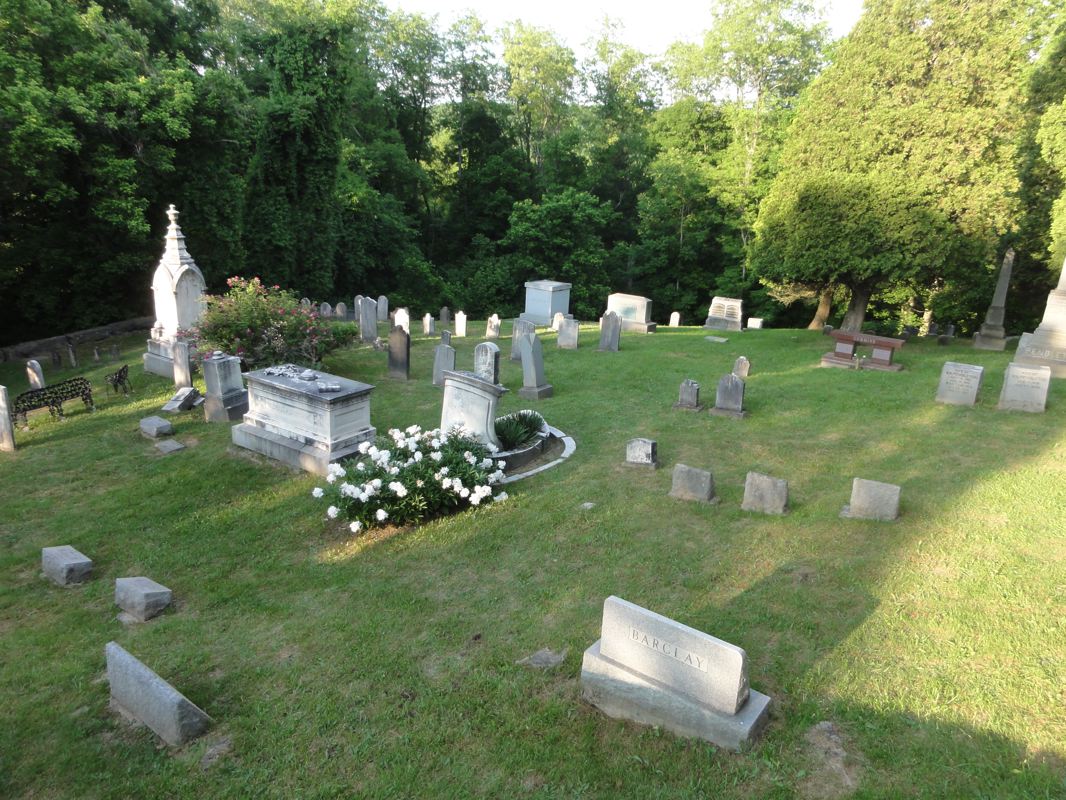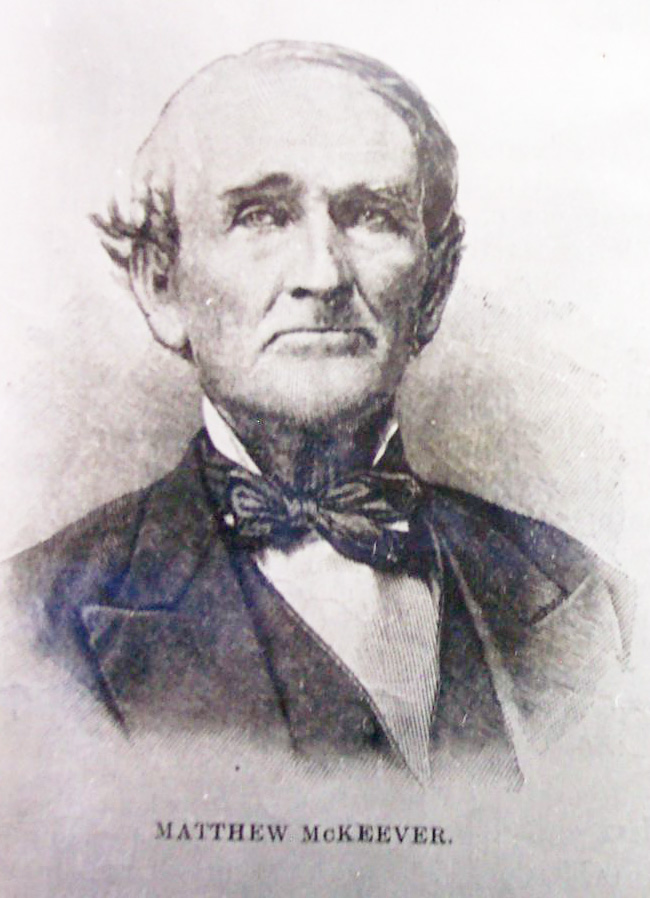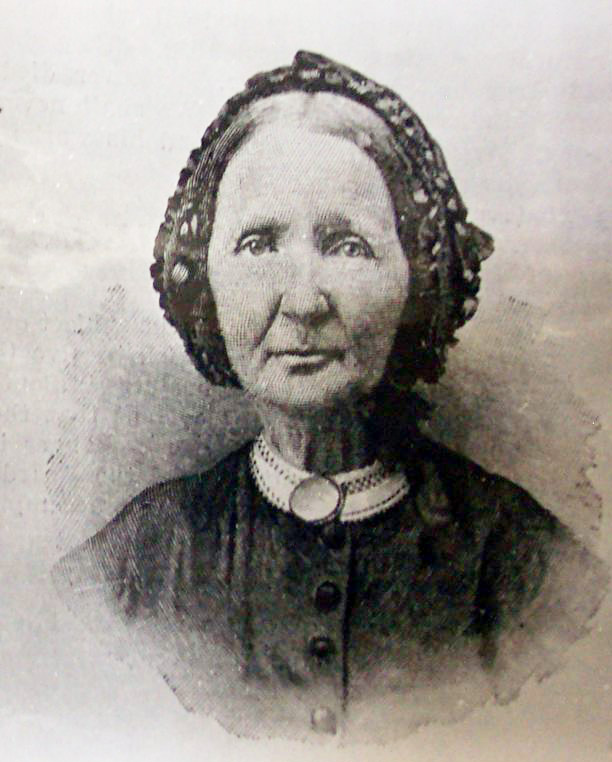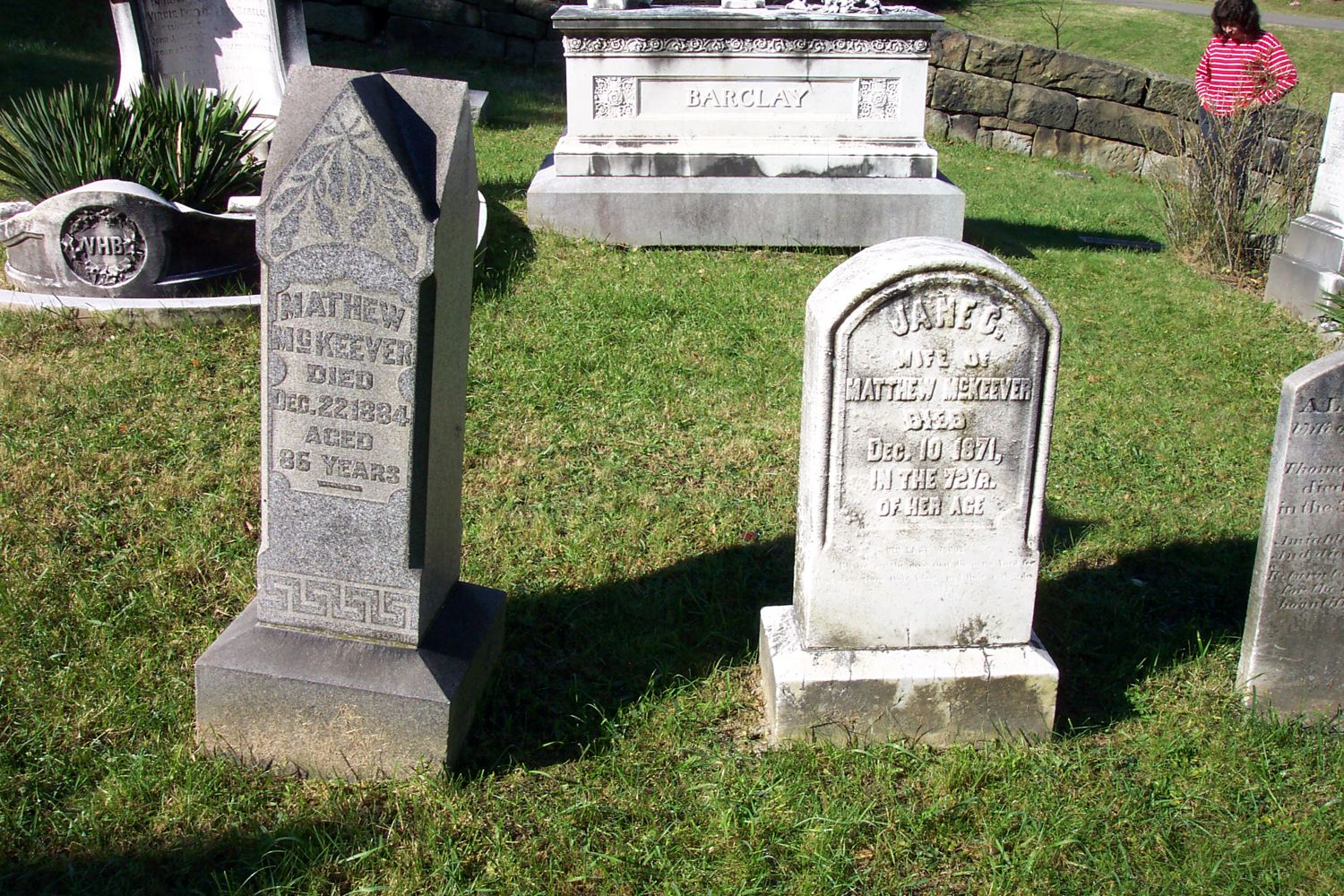Matthew McKeever
1797-1884
Jane Corneigle Campbell McKeever
1800-1871
Photos Found In McKeever Study in West Middletown, Pennsylvania in 2005
![]()
The McKeever Family
Early influential family in the reform movement of Thomas and Alexander Campbell.
In 1792 William (1758-1838) and Mary McFadden McKeever (1767?-1840) moved from Ireland to the United States, eventually settling in West Middletown, Pennsylvania, in 1794. Originally Methodists, the McKeevers and their descendants played important roles in the first half-century of the Stone-Campbell Movement. Although not members of the original Brush Run church, the McKeevers joined the Disciples congregation that formed in the late 1829s after the Brush Run church disbanded. The newly formed congregation met in a building owned by Matthew McKeever, son of William and Mary, until a church was built in 1837.
William was the first in a long line of McKeever abolitionists and ran a station on the Underground Railroad, as did his sons Thomas and Matthew (husband of Alexander Campbell's sister Jane). More than once escaped slaved were recaptured on Matthew's farm, only to be released to freedom by order of a local Justice of the Peace-in one case, Thomas McKeever himself. Even Matthew and Jane's son, Thomas Campbell McKeever, helped smuggle slaves to freedom while a student at Bethany College.
The McKeevers also were active in early Disciples educational efforts. Jane Campbell, then her son Thomas Campbell McKeever, ran Pleasant Hill Female Seminary for about twenty-five years, starting in 1842. After Thomas's death in 1866, his wife, Martha McAyle McKeever, became superintendent until Pleasant Hill closed in the early 1870s. Matthew and Jane's daughter, Mary Jane Campbell McKeever, conducted schools in Kentucky, Missouri, and Oregon, while another daughter, Lorinda McKeever Wilkin, and a granddaughter, Ella McKeever, taught at Pleasant Hill.
Bibliography, Bernice Bartley Bushfield, The McKeevers and Allied Families of West Middletown, Washington County, Pennsylvania (1959) - Boyd Crumrine, ed., History of Washington County, Pennsylvania (1882) - Matthew McKeever, "The Underground Railroad" (unpublished manuscript, 1880, Bethany College Archives).
-John H. Hull, The Encyclopedia of the Stone-Campbell Movement: page 509
![]()
Jane Campbell McKeever: Founder Of Pleasant Hill Seminary
Many of us think we know the story well. This child of Thomas and Jane Campbell was born in Ireland and emigrated to western Pennsylvania at a relatively young age. Recognizing the need for education on what was then the American frontier, this younger Campbell opened a home school and educated local and family children. Eventually, home schooling gave way to higher education, and this Campbell child founded a private, nonsectarian institution to provide college-level education for students of the United States and Canada. This person guided the educational institution for a quarter of a century, until it was widely recognized as one of the best of its kind in the country. Indeed, the institution was known for providing graduates who helped found and teach in many other institutions. Finally, not long after the Civil War, this person died and was recognized, among other things, as a pivotal person in the development of restoration movement higher education.
This sounds like the familiar story of Alexander Campbell. But in this case, the story is not about Alexander, but about his sister Jane Campbell, whose story is also important in the history of the restoration movement. (John H. Hull, "Jane Campbell McKeever," Discipliana, 52 *spring, 1992), p.7)
Jane Campbell was born on June 25, 1800, in Ahorey, Ireland, the daughter of Jane and Thomas Campbell, and the younger sister of Alexander. Thomas Campbell emigrated to the U.S. in 1807; Jane followed with the rest of her family in 1809. They settled in Washington, Pennsylvana, within twenty miles of Bethany, Virginia (now West Virginia). What little is known about Jane's early education shows she was tutored at home by Alexander. (Robert Richardson, Memoirs Of Alexander Campbell, Volume I, (Philadelphia: J.B. Lippincott & Co. , 1871), pp. 40-46, 78-79, 204, 279.)
Between 1809 and 1820, Jane's family moved several times. In 1813, in Cambridge, Ohio, she was a student in her father's mercantile academy. (Alexander Campbell, Memoirs of Elder Thomas Campbell(Cincinnati: H.S. Bosworth, 1861), p.123) She also may have been a student in a similar academy Thomas ran in Pittsburgh, Pennsylvania in 1815. (Lester G. McAllister, Thomas Campbell: Man of the Book(St. Louis: Bethany Press, 1954), p.175.) After her family moved to Kentucky in 1817, Jane began, at the age of eighteen, her long career as an educator. Her reputation as a fine teacher grew rapidly, and helped make the Kentucky school popular, as well as profitable. Because of his opposition to some of Kentucky's proslavery laws, Thomas moved his family back to Pennsylvania in 1819, settling in West Middletown, Pennsylvania, the village in which Jane would live for the next half century. Kentuckians were so impressed with Jane's teaching ability that they argued unsuccessfully for her to stay behind to teach when her family returned North. (Richardson, Memoirs, pp.494-496.)
In West Middletown, Jane, nineteen, opened a home school for girls and boys. (Phoebe A. Murdock, Pleasant Hill Seminary(unpublished manuscript, no date), p.1, in the Pleasant Hill Seminary Collection of Jane Fulcher, West Middletown, Pennsylvania.) Two years later, Jane married Matthew McKeever. She taught at home during some of the next twenty years, while participating in the family and wool business and raising a family that eventually numbered more than twenty natural and adopted children. (Letter from Lorinda McKeever Wilkin to William T. Lindsey (March 15, 1910), Pleasant Hill Seminary Collection of Jane Fulcher, West Middletown, Pennsylvania). By 1830 the home school was known as Pleasant Hill Seminary, still educating boys as well as girls.
In 1840, Jane's brother Alexander founded Bethany College in nearby Bethany. (West) Virginia. About two years later, Jane's school outgrew the McKeever home, was moved to a new building, and became Pleasant Hill Female Seminary. Jane, the seminary's founder, served as its "principal" for most of the next quarter century.(See for example the following Millennial Harbingerarticles: "Pleasant Hill Seminary," series 3, volume 4, (September, 1847), p.537; A.C., "Pleasant Hill Seminary," series 3, volume 5, (August, 1848) p.479; "Pleasant Hill Female Seminary," series 3, volume 7, (August, 1850), pp.474-475; Isaac Errett, "Meeting at West Middletown, Pa., and Pleasant Hill Seminary," series 4, volume 6, (September, 1856), p.539; R.M., "Pleasant Hill Female Seminary," series 4, volume 7, (November, 1857), p.658; and Twenty-first Annual Catalogue of Pleasant Hill Female Seminary 1866-1867 (Washington, Pennsylvania: Reporter Steam Book And Job Office, 1867), p.4)
The seminary was an important educational institution in the restoration movement. The school's three-year curriculum covered some material now taught in a typical high school, although many of its courses and texts were identical to those taught in four-year colleges at the time, including nearby Bethany. (For example, Twenty-third Annual Catalogue of Pleasant Hill Female Seminary, 1868-1869, (Wilmington, Ohio: Garvin & Lowry, 1869), pp.4,5,12,13, Catalogue of Bethany College, 1870(Wheeling: Frew, Hagans, & Hall, 1870), pp.13-20). Further, some of the courses offered at the seminary-painting and drawing, vocal and instrumental music-were not commonly taught at four-year colleges then, but are now part of a standard liberal arts curriculum. There was also at the seminary an emphasis on spiritual values and beliefs. Students were free to attend the church of their choice, although the seminary's Catalogue made clear that, "if no special instructions are given they will attend church with the matron, and be under her special care." (For example, Sixteenth Annual Catalogue of Pleasant Hill Female Seminary, 1861-1862(Washington, Pennsylvania: Reporter and Tribune Book and Job Office, 1862), p.18) Both Alexander Campbell and William Pendleton, presidents of Bethany College, attested to the academic excellence of the institution in comparison with other colleges for females or for males. (For example, A.C., "Pleasant Hill Seminary, Washington County, Pennsylvania," Millennial Harbinger, series 5, volume 1, (August, 1858) p. 480; W.K.P., "Pleasant Hill Female Academy," Millennial Harbinger, 36, (August, 1865) p.381
But more than education happened at Pleasant Hill. Jane and Matthew McKeever were described by a contemporary as "rank abolitionists," and were friends of John Brown of Kansas and Harper's Ferry fame, who was also a wool dealer. Pleasant Hill was an important station on the local "underground railroad," spiriting slaves to freedom in Canada. (Ernest F. Atcheson, "Editorial Correspondence. The Pleasant Hill Seminary—A Noted Educational Institution of the Past," The Washington[Pa.] Observer(no volume listed on the copy available), (September 6, 1888) (no page number listed on copy available), Pleasant Hill Seminary Collection of Jane Fulcher, West Middletown, Pennsylvania. Apparently, Jane's antislavery sentiments were much strong-or at least more clearly demonstrated-than those of her nearby brother. In one of the few examples of her writing extant, Jane says, in a letter published in the abolitionist North-Western Christian Magazine:
I truly rejoice to find that ONE of our brotherhood has had the fortitude, and independece [sic] of mind, to rise superior to the reproach and opposition of so many of his professed christian brethren, in behalf of the poor, oppressed and degraded slaves . . . .I trust that you will be encouraged to persevere, believing that god, who in all generations has been the God of the oppressed . . .wills strengthen you, and bless your efforts in the good cause for which you plead. I intend to exert my influence in this vicinity amongst our brethren in behalf of your magazine. (Jane F. McKeeever, "Interesting Letter," North-Western Christian Magazine, 1, (November, 1854) pp. 153-154.)
In 1866, Jane determined to hand over control of the seminary to her son and Bethany College graduate, Thomas Campbell McKeever. Only months into his principalship, Thomas died, and Jane resumed leadership in Pleasant Hill Seminary until 1868, when she finally did retire. Without her strong leadership, the seminary rapidly withered; its last graduating class was in 1869, and it closed some time in the mid-1870s. Hundreds of women from the United States and Canada attending the seminary during the three decades of existence; 165 graduated, receiving "Mistress of Arts" degrees. (For example, Sixteenth Annual Catalogue of Pleasant Hill Female Seminary1861-1862, p.18)
What do we know of those graduates? Besides the societal restricted range of acceptable careers and activities for women in the late 1800s and early 1900s, several went on to make important contributions to the restoration movement, including: Jennie Reader Errett (class of 1860), who, with her father, then her brother, ran the Christian Standard from its first publication in 1866 until her death in 1927; Sarah Jane McFarland (1852), who taught at Pleasant Hill for fifteen years, then at a series of restoration movement-related colleges from Kentucky to Calfornia; Mary J. Cooney (1869), a public school teacher, generous benefactor of her church, and a life member of the Christian Woman's Board of Missions; Lorinda McKeever Wilkin (1848), daughter of Jane, teacher at Pleasant Hill, and author of many religious articles and pamphlets; Decima Campbell Barclay (1856), daughter of Alexander Campbell and prominent churchwoman throughout her long life; and Rebecca C. Jones (1847), highly respected teacher at Wellsburg (West Virginia) Female Seminary and other institutions. (I have collected data on these and about thirty othere Pleasant Hill Seminary graduates from Christian Standardand Christian-Evangelistarticles, the Brooke County (Wellsburg, West Virginia) Public Library Archives, and from Jane Fulcher of West Middletown, Pennsylvania.)
Jane Campbell McKeever lived with her daughter, Lorinda, in Harrisville, Ohio from the time she left West Middletown and Pleasant Hill Seminary until her death on December 10, 1871. ("Died," Christian Standard, 7, (January 6, 1872) p.5) Such was the importance of her work and leadership, that her picture was in the middle of the pictures of seventeen women "influential in the Restoration Movement," in a 1916 issue of the Christian Standard. ("Women Influential in the Restoration Movement," Christian Standard, 51, (April 8, 1916) p.1011)
Pleasant Hill Seminary closed its doors, and Jane Campbell McKeever died more than a hundred years ago, but what she accomplished through her educational work is an inspiration to us all. After the Pittsburgh, Pennsylvania, Centennial Convention of 1909, about one hundred former Pleasant Hill Seminary students, including several mentioned in this chapter, gathered in in a last great reunion. No more fitting tribute to Jane Campbell McKeever and her seminary could have been written than that penned by Jennie Errett in the Christian Standard, as she described the reunion: "Our next great reunion will include those who have gone before among the hosts of the redeemed, to sing with them the song of Jesus, the Lamb of God, whose we are and whom we serve." (J. R. E., "Pleasant Hill Seminary," Christians Standard, 46, (August 13, 1910) p.1397)
-Debra Beery Hull, Christian Church Women, Shapers of a Movement, pages 87-90
Note: The piece above was gleaned from a greater work written by John H. Hull. It appeared in the book entitled, Christian Church Women, by Debra Beery Hull. The footnote on page 113 says the following: "John H. Hull, this chapter's writer, is professor of psychology and department head at Bethany College. He has studied extensively Pleasant Hill Female Seminary and the work of Jane Campbell McKeever. Currently, he is researching the stories of Disciples who were active in the underground railroad. He would like to thank several people for their help with this chapter. R. Jeanne Cobb, Bethany College Archives, Bethany, West Virginia; David McWhirter adn the staff of the Disciples of Christ Historical Society, Nashville, Tennessee; Jane Fulcher, local historian, West Middletown, Pennsylvania; and the archival staff of the Brooke County, West Virginia, Public Library."
![]()
That Which Remains Of Pleasant Hill Female Seminary
Location:
122 Seminary Rd.
West Middletown, Pennsylvania
GPS Location
40.252159,-80.43647

All that is left of the old Female Seminary is the old part of the house above, highlighted on the left

Now part of a private home, most everything connected to the college is gone
![]()
Location of the Burial Of Matthew & Jane McKeever
The McKeevers are buried in God's Acre Cemetery in the remote hills of the panhandle of West Virginia. Access of approach to Bethany can be made four ways, one of which is not great if you are prone to car sickness. The approach from Wheeling, W.V. is very curvy, on Hwy. 88. Thus, it is better from Wheeling to go up Hwy. 2, following the Ohio River to Wellsburg. Turn right on Hwy. 27 and go around five miles and turn right on Hwy. 88. Access this way is straightest from Wheeling. Once arriving in Bethany, travel all the way through, passing the church building on the right, crossing Buffalo River/Creek, passing the soccer fields on the left, and continuing until you get to the Campbell Mansion. When you see the historical marker on the right, you should turn right, but keep to the left as you go up the hill toward God's Acre Cemetery. The cemetery is enclosed with large boulders. Enter the cemetery at the steps. The McKeevers are buried in the same row as Thomas and Jane Campbell, Jane Campbell McKeever's mother and father..
From Washington, P.A. - Take Exit 17/Jefferson Avenue on I-70, and head north, (away from Washington) on Hwy. 18/844. When 18 and 844 split, be sure to go left on 844. Go a few miles and turn left on Hwy 331/Brush Run Road. (There has for years been a red barn at the corner, making for a good landmark to know where to turn off Hwy. 844. onto Hwy. 331/Brush Run Road. Take 331 until it dead's end to Hwy. 231 where you will turn left. Hwy. 231 will dead back into Hwy. 331. Turn right and head into Bethany. The first glimpse of Bethany will be the old Campbell mansion on the right. Be sure to go through this house if possible. It is good to call ahead to make sure someone is able to show you through. You can not get in on your own. But, continue just past the mansion and turn left on the little road that give you access to the cemetery. Be sure to stay to your left as you make your way up the hill. The cemetery is enclosed with large boulders. The McKeevers are buried in the same row as Thomas and Jane Campbell, Jane Campbell McKeever's mother and father.
GPS Location of The Graves of the McKeevers
D.d 40.205443,-80.546734
View Larger Map
![]()

McKeevers in Middle of Picture in front of coffin shaped above-ground grave of Decima Campbell Barclay
Matthew McKeever
Born 1797
Died
December 22, 1884
Aged
86 Years
Jane
C.
Wife Of Matthew McKeever
Born 1800
Died
December 10, 1871
In The 72Yr. Of Her Age
![]()



